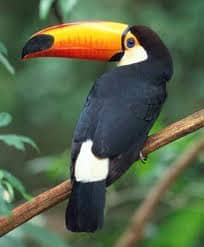GPS Tracking Devices Help Smithsonian Scientists Study Seed Dispersal
 In Panama, scientists form the Smithsonian Institute are using GPS tracking devices to gather data on how Toucans disperse seeds.
In Panama, scientists form the Smithsonian Institute are using GPS tracking devices to gather data on how Toucans disperse seeds.
Toucans love nutmeg seeds. When Toucans eat, they gulp the nutmeg seeds whole. The outer pulp is processed in the bird’s crop, and the hard inner seed is then regurgitated.
There were were two main things scientists had to do to set up the experiment. First, the scientists had to figure out how long and how many seeds the Toucans would eat in a day. So the scientists gathered fresh seeds from a nutmeg tree and fed them to captive toucans at the Rotterdam Zoo.
During the GPS tracking experiment, five zoo toucans fed 100 nutmeg seeds took an average of 25.5 minutes to process and regurgitate the seeds.
Next the scientists captured six wild toucans that were feeding from a large nutmeg tree in the rainforest. The scientists attached lightweight backpacks containing GPS tracking devices to the wild birds.The GPS tracking devices recorded the birds’ exact location every 15 minutes and used accelerometers to measure the Toucans’ daily activity level.
The GPS-enabled backpacks are designed to fall off the Toucans after 10 days.
When matched with the seed-regurgitation time of the zoo toucans, the GPS tracking data indicated the wild toucans were probably dropping nutmeg seeds a distance of 472 feet, on average, from the mother tree. Each seed had a 56 percent probability of being dropped at least 328 feet from its mother tree and an 18 percent chance of being dropped some 656 feet from the tree. In addition, the accelerometer revealed that the toucans’ peak activity and movement was in the morning followed by a lull at midday, a secondary activity peak in the afternoon, and complete inactivity at night. This is a normal pattern of tropical birds.
“Time of feeding had a strong influence on seed dispersal,” the scientists write. “Seeds ingested in morning (breakfast) and afternoon (dinner) were more likely to achieve significant dispersal than seeds ingested mid-day (lunch).” This observation explains why tropical nutmegs are “early morning specialists” with fruits that typically ripen at early and mid-morning so they are quickly removed by birds.
Ideally, the scientists observed, nutmeg trees could increase their seed dispersal distances by producing fruit with gut-processing times of around 60 minutes.
Source: The original article, “The effect of feeding time on dispersal of Virola seeds by toucans determined from GPS tracking and accelerometers,” was recently published in the journal Acta Oecologica.